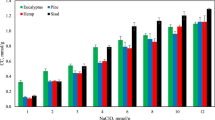Abstract
Non-destructive methods of sampling during the physicochemical studies of historical objects such as old books and manuscripts seem to be an obvious choice. Since furfural has been shown to be one of the most abundant gaseous products of cellulose degradation, it can be considered as a convenient marker of degradation progress. The number of quantitative data concerning correlations between the emission of furfural and physicochemical and mechanical properties of paper is rather scarce in the literature. In the present studies, a model paper containing more than 99% of cellulose was aged inside closed vials at 90°C. Gaseous products of paper degradation were measured using sorption tubes filled with Tenax TA sorbent and GC-MS. The method has proved to be sufficiently sensitive for measuring furfural emission not only in accelerated degradation at 90°C but also during natural ageing of paper at room temperature even in relatively short time intervals of 2–28 days. The correlations between furfural emission and polymerization degree, pH, color, tear index, number of double folds and breaking length have been statistically confirmed at confidence level α=0.001. Basing on them it was possible to estimate the number of broken glycosidic bonds per one molecule of furfural formed during degradation—we found a value equal to 9.2.
Similar content being viewed by others
References
E. Ott (ed.), Cellulose and Cellolose Derivatives. High Polymers (Interscience, New York, 1943)
G. Buchbauer, L. Jirovetz, M. Wasicky, A. Nikiforov, J. Pulp Pap. Sci. 21, 398–400 (1995)
K. Wiik, T. Helle, Nord. Pulp Pap. Res. J. 14, 268–272 (1999)
A. Lattuati-Derieux, S. Bonnassies-Termes, B. Lavedrine, J. Chromatogr. A 1026, 9–18 (2004)
T. Doering, P. Fisher, U. Binder, J. Liers, G. Banik, in Advances in Paper and Board Performance, Proceedings of the 27th Research Conference of IARIGAI, Graz, Austria, ed. by J.A. Bristow, Advances in Printing Science & Technology, vol. 27, 10–13 September 2002
M. Strlič, I. Kralj Cigić, J. Kolar, G. de Bruin, B. Pihlar, Sensors 7, 3136–3145 (2007). www.mdpi.org/sensors
O. Ramalho, A.-L. Dupont, C. Egasse, A. Lattuati-Derieux, in Emission Rates of VOC from Paper versus Cellulose Degradation: An Integrated Approach to Paper Characterization, 8th Indoor Air Quality 2008 Meeting, Kunsthistorisches Museum, Vienna, 17–19 April 2008
A. Lattuati-Derieux, S. Bonnassies-Termes, B. Lavedrine, J. Cult. Herit. 7, 123–133 (2006)
ASTM D6819-02. Standard Test Method for Accelerated Temperature Ageing of Printing and Writing Paper by Dry Oven Exposure Apparatus, Reapproved, 2007
J.B.G.A. Havermans, M.A.P.C. de Feber, W.J.L. Genuit, G.J. van Venzel, in Proceedings of the ICOM Committee for Conservation (James and James Science, London, 1999), p. 513
A.M. Emsley, G.C. Stevens, Cellulose 1, 26–56 (1994)
Y. Houminer, S. Patai, Isr. J. Chem. 7, 513 (1969)
F. Shafizadeh, Y.Z. Lai, J. Org. Chem. 37, 278 (1972)
J. Scheirs, G. Camino, M. Avidano, W. Tumiatti, J. Appl. Polym. Sci. 69, 2541–2547 (1998)
The Effects of Air Pollutants on the Accelerated Ageing of Cellulose Containing Materials—Paper. Step Project CT 90-0100, The Joint Report of TNO, Centre for Paper and Board Research; CRCDG, Centre de Recherches sur la Conservation des Documents Graphiques; STFi, Swedish Pulp and Paper Research Institute; Chalmers University of Technology and Göteborg University, p. 62
TAPPI standard T509 om-02; Hydrogen ion concentration (pH) of paper extracts (cold extraction method)
C.J. Shahani, S.B. Lee, F.H. Hengemihle, G. Harrison, P. Song, M.L. Sierra, C.C. Ryan, N. Weberg, Accelerated Aging of Paper, Research Program on Effects of Aging on Printing and Writing Papers at the ASTM Institute for Standards Research, December 2001
T. Sawoszczuk, A. Barański, J.M. Łagan, T. Łojewski, K. Zięba, J. Cult. Herit. 9, 401–411 (2008)
Scandinavian Pulp, Paper and Board Testing Committee, Scan-CM 15:88 Standard, Rev. 1988
K. Zięba, Ph.D. Thesis, Jagiellonian University, Faculty of Chemistry, 2009
R. Stol, J.L. Pedersoli Jr., H. Poppe, W.T. Kok, Anal. Chem. 74, 2314–2320 (2002)
Zero Span-Breaking Strength of Pulp (Dry Zero Span Tensile)
T. TAPPI Method, 414 om-98 Internal tear resistance of paper
TAPPI standard T511 om-96; Folding endurance of paper (MIT tester)
M. Strlič, J. Kolar, D. Kočar, T. Drnovsek, V.-S. Selih, R. Susic, B. Pihlar, e-Preserv. Sci. 1, 35–47 (2004)
W.E. Scott, J.C. Abbott, S. Trosset, Properties of Paper: An Introduction (TAPPI Press, Atlanta, 1995)
D. Fengel, G. Wegener, Wood Chemistry, Ultrastructure, Reactions (Walter de Gruyter, Berlin, 1984)
X. Zou, T. Uesaka, N. Gurnagul, Cellulose 3, 243–267 (1996)
A. De Pablo, Furfural and ageing: How are they related. IEEE Xplore. www.ieeexplore.ieee.org/stamp/stamp.jsp?arnumber=790744&isnumber=17183
T. Sawoszczuk, PhD thesis, Faculty of Chemistry, Jagiellonian University, Kraków, 2009
T. Łojewski, T. Sawoszczuk, Pol. Pap. Rev. 64, 319–322 (2008)
J.C. Roberts, The Chemistry of Paper (The Royal Society of Chemistry, 1996)
Author information
Authors and Affiliations
Corresponding author
Rights and permissions
About this article
Cite this article
Łojewski, T., Sawoszczuk, T., Łagan, J.M. et al. Furfural as a marker of cellulose degradation. A quantitative approach. Appl. Phys. A 100, 873–884 (2010). https://doi.org/10.1007/s00339-010-5663-7
Received:
Accepted:
Published:
Issue Date:
DOI: https://doi.org/10.1007/s00339-010-5663-7




